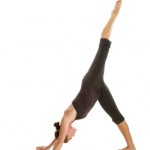Special thanks to: aurawellnesscenter.com.
By Gopi Rao
How can we protect the knees of our students during class time? Knees are one of the most vulnerable parts of the human anatomy. No matter what type of fitness regimen you choose, the knees will often take a beating. Very few sports spare the vulnerable knee, and it is common to see all kinds of athletes, including runners, tennis players, and dancers wearing knee stabilizers.
There are no knee opening poses in yoga, so it is important to take a few precautions, which prevent injury, but also strengthen the area around the knee-joint.
Preventative Actions:
1. Alignment: The single most important factor in relation to your knees is alignment. Toes always point in the same direction as the knee.
2. Engage the Feet: Activate your feet when beginning a posture by raising your toes, which will strengthen your lower legs. Spreading your toes will give you stability.
3. Evenly Distribute Your Weight: Try not to favor one leg over the other, even in warrior poses. Many will put all the weight on the bent knee. Be particularly careful when moving out of a pose, which is when more likelihood of injury could occur.
4. Practice Balancing: Balance poses are great leg strengtheners. Strong legs give good support for the knees and aid in taking the pressure off the joint.
5. Knees Straight Upwards: Keep awareness of your knees in seated poses. Be careful not to allow your toes and knees to roll out. Tightening your thigh muscle will lift your knee.
Protect the Knees to Avoid Dangers:
1. Hyperextension: Don’t lock the knees. If you feel you are prone to hyperextension, keep a slight bend in the knee. Extreme hyperextension can cause ligament tears.
2. Full Lotus: Many knee injuries occur when people force full lotus before they are ready. The rotation of the knee in this pose is tricky, so it is advisable to start with half lotus.
Protect the Knees with Props:
1. Blocks: Yoga blocks can be placed under knees that don’t fall to the ground when in sitting poses, such as bound angle pose.
2. Blankets: Many people will feel relief from using a blanket as padding when engaged in postures, which put direct pressure on the knees, like table, cat, or cow. You may also fold a blanket and place it between the thigh and the calf to reduce the bend in the knee, in postures such as child or hero.
Be good to your knees, and give them the focus and attention they need to stay healthy and strong.
© Copyright – Aura Wellness Center – Publications Division
See our testimonials to find out what our graduates have to say about teaching therapeutic yoga sessions and our selection of online yoga instructor training intensive courses.
If you are a teacher, yoga school manager, blogger, e-zine, or website publisher, and are in need of quality content, please feel free to use my blog entries (articles). Please be sure to reprint each article, as is. Namaste!
Related Posts
About Hatha Yoga for Preventing Knee Injuries
What Can Yoga Asanas Do For Skeletal Alignment?
Four More Yoga Posture Safety Tips


